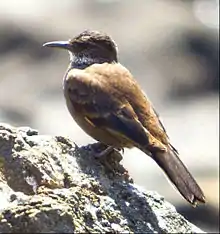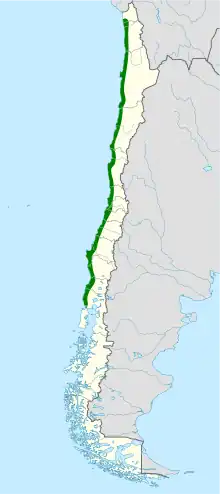Chilean seaside cinclodes
The Chilean seaside cinclodes or simply seaside cinclodes[2] (Cinclodes nigrofumosus) is a species of bird in the Furnariinae subfamily of the ovenbird family Furnariidae. It is endemic to Chile.[3]
| Chilean seaside cinclodes | |
|---|---|
 | |
| Scientific classification | |
| Domain: | Eukaryota |
| Kingdom: | Animalia |
| Phylum: | Chordata |
| Clade: | Dinosauria |
| Class: | Aves |
| Order: | Passeriformes |
| Family: | Furnariidae |
| Genus: | Cinclodes |
| Species: | C. nigrofumosus |
| Binomial name | |
| Cinclodes nigrofumosus (D'Orbigny & Lafresnaye, 1838) | |
 | |
| Synonyms | |
| |
Taxonomy and systematics
The Chilean seaside cinclodes and the Peruvian seaside cinclodes (C. taczanowskii) have on and off been considered separate species and conspecific.[4] Studies in the twenty-first century show that they are very weakly differentiated genetically. As of 2023 they are treated as sister species, and the two are sister to the dark-bellied cinclodes (C. patagonicus).[5] The South American Classification Committee of the American Ornithological Society is seeking a proposal to consider merging them.[4]
Description
The Chilean seaside cinclodes is 21 to 27 cm (8.3 to 11 in) long and weighs 63 to 67 g (2.2 to 2.4 oz). It is a large cinclodes with a straight bill. The sexes have the same plumages. Adults have narrow pale buff or whitish supercilium on an otherwise blackish brown face. Their crown and upperparts are smoky black or blackish brown. Their wings are blackish with a pale rufous band at the base of the flight feathers. Their tail is black; the outer three pairs of feathers have pale rufous or ashy-brown tips. Their throat and the sides of the neck are white, their upper breast smoky gray with small white or pale cinnamon dots, their lower breast smoky gray with light cinnamon streaks, and their belly plain smoky gray.Their iris is brown or dark brown, their bill blackish, sometimes with a gray base on the mandible, and their legs and feet brownish gray to blackish. There is some hint that the species' plumage is clinal, with northern birds being somewhat paler than southern ones.[6][7]
Distribution and habitat
The Chilean seaside cinclodes is found along the Chilean coast from the Arica y Parinacota Region south to the Los Ríos Region, and on several nearshore islands. It inhabits the intertidal zone where it greatly favors rocks.[6][7]
Behavior
Movement
The Chilean seaside cinclodes is a year-round resident throughout its range and is seldom far from the water's edge.[6]
Feeding
The sister Chilean and Peruvian seaside cinclodes are the only passerines that forage at the ocean's surf line. The Chilean seaside cinclodes forages singly or in pairs in the intertidal zone and adjacent sandy areas. It feeds on aquatic invertebrates such as small crabs and other crustaceans, marine worms, small bivalves and snails, limpets, and insects, and also on small fish.[6]
Breeding
The Chilean seaside cinclodes' breeding season extends at least from August to January and possibly beyond. Males make a courtship and territorial display from a high rock by opening their wings and singing. The species makes a messy nest of herbs, algae, and lichen in a cavity in rocks, in a burrow it digs in an earthen bank, in roofs or other human structures, and even in abandoned pipes. The clutch size is two to four eggs. The incubation period and time to fledging are not known. Both parents provision nestlings.[6]
Vocalization
The song of the Chilean seaside cinclodes is a "bright trilled series of piping whistles" that pairs sometimes sing in duet. Its calls include a "short, sharp, slightly metallic chik" that may be uttered in a series and a "repeated more subdued drier chuk" made by an adult feeding young.[6]
Status
The IUCN has assessed the Chilean seaside cinclodes as being of Least Concern. It has a fairly large range and an unknown population size that is believed to be stable. No immediate threats have been identified.[1] It is considered locally fairly common but occurs in very few protected areas. Its habitat "could be altered by human activities at the coast line, such as constructions or other activities that alter the intertidal zone".[6]
References
- BirdLife International (2016). "Chilean Seaside Cinclodes Cinclodes nigrofumosus". IUCN Red List of Threatened Species. 2016: e.T22702107A93860325. doi:10.2305/IUCN.UK.2016-3.RLTS.T22702107A93860325.en. Retrieved 4 September 2023.
- Clements, J. F., T. S. Schulenberg, M. J. Iliff, T. A. Fredericks, J. A. Gerbracht, D. Lepage, S. M. Billerman, B. L. Sullivan, and C. L. Wood. 2022. The eBird/Clements checklist of birds of the world: v2022. Downloaded from https://www.birds.cornell.edu/clementschecklist/download/ retrieved November 10, 2022
- Gill, Frank; Donsker, David; Rasmussen, Pamela, eds. (July 2023). "Ovenbirds, woodcreepers". IOC World Bird List. v 13.2. Retrieved July 31, 2023.
- Remsen, J. V., Jr., J. I. Areta, E. Bonaccorso, S. Claramunt, G. Del-Rio, A. Jaramillo, D. F. Lane, M. B. Robbins, F. G. Stiles, and K. J. Zimmer. Version 31 May 2023. A classification of the bird species of South America. American Ornithological Society. https://www.museum.lsu.edu/~Remsen/SACCBaseline.htm retrieved May 31, 2023
- Derryberry, E. P., S. Claramunt, G. Derryberry, R. T. Chesser, J. Cracraft, A. Aleixo, J. Pérez-Emán, J. V. Remsen, Jr., and R. T. Brumfield. (2011). Lineage diversification and morphological evolution in a large-scale continental radiation: the Neotropical ovenbirds and woodcreepers (Aves: Furnariidae). Evolution 65(10):2973–2986. https://doi.org/10.1111/j.1558-5646.2011.01374.x
- Pantoja, V., F. Medrano, A. Vielma, T. S. Schulenberg, A. Jaramillo, and P. F. D. Boesman (2021). Seaside Cinclodes (Cinclodes nigrofumosus), version 2.0. In Birds of the World (T. S. Schulenberg and B. K. Keeney, Editors). Cornell Lab of Ornithology, Ithaca, NY, USA. https://doi.org/10.2173/bow.seacin1.02 retrieved September 4, 2023
- de la Peña, Martín R.; Rumboll, Maurice (2001). Birds of Southern South America and Antarctica. Princeton Illustrated Checklists. New Jersey: Princeton University Press. pp. Plate 61. ISBN 0691090351.
Further reading
- Ridgely, Robert S.; Tudor, Guy (2009). Field Guide to the Songbirds of South America: The Passerines. University of Texas Press. p. 71. ISBN 978-0-292-71748-0.
- Chester, Sharon (2010). A Wildlife Guide to Chile: Continental Chile, Chilean Antarctica, Easter Island, Juan Fernández Archipelago. Princeton University Press. p. 248. ISBN 978-1-4008-3150-0.
 Media related to Cinclodes nigrofumosus at Wikimedia Commons
Media related to Cinclodes nigrofumosus at Wikimedia Commons Data related to Cinclodes nigrofumosus at Wikispecies
Data related to Cinclodes nigrofumosus at Wikispecies
